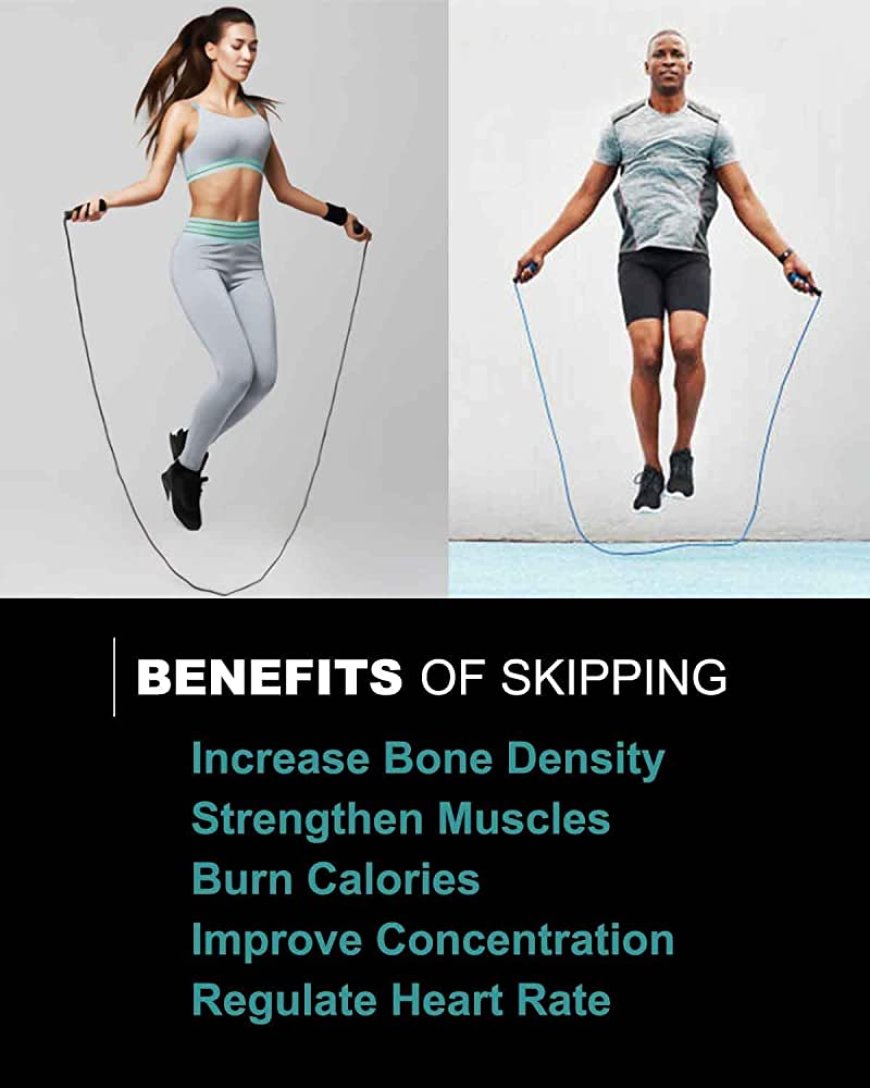Skipping exercises for fitness

Skipping exercises for fitness
Skipping, also known as jump rope, is a great exercise for improving cardiovascular fitness, coordination, and overall health. It is a high-intensity, full-body workout that can burn calories, strengthen muscles, and improve bone density.
Here are some potential health benefits of skipping:
-
Cardiovascular fitness: Skipping is an excellent aerobic exercise that gets your heart pumping, improving your cardiovascular health and endurance. Regular skipping can help lower the risk of heart disease and improve blood circulation.
-
Weight management: Skipping can be an effective exercise for weight loss as it burns a significant amount of calories. The intensity of skipping can help you burn calories quickly and contribute to a calorie deficit, which is essential for weight management.
-
Bone density: Skipping is a weight-bearing exercise that puts stress on your bones, helping to strengthen them and improve bone density. This can be particularly beneficial for preventing osteoporosis and reducing the risk of fractures.
-
Coordination and balance: Jumping rope requires coordination and timing, which helps improve your motor skills and balance. Regular skipping can enhance your overall body coordination and agility.
-
Full-body workout: Skipping engages multiple muscle groups simultaneously, including your legs, core, arms, and shoulders. It helps tone and strengthen these muscles, leading to improved muscle endurance and overall body strength.
-
Mental health benefits: Like any form of exercise, skipping can have positive effects on your mental well-being. Physical activity releases endorphins, which are known as "feel-good" hormones, promoting a sense of happiness, reducing stress, and improving mental clarity.
How to start Skipping
To start incorporating skipping into your fitness routine, follow these steps:
-
Get the right equipment: Purchase a suitable jump rope that is the correct length for your height. Ideally, the handles should reach your armpits when you stand on the middle of the rope.
-
Warm up: Before you begin skipping, it's essential to warm up your body with some light cardio exercises such as jogging in place, jumping jacks, or dynamic stretches. This helps increase blood flow, loosen up your muscles, and reduce the risk of injury.
-
Start with basic jumps: Begin with basic jumps, also known as two-footed jumps. Stand with your feet together, hold the handles of the jump rope, and swing it over your head. Jump with both feet, keeping your knees slightly bent and your elbows close to your sides. Land softly on the balls of your feet and repeat the motion.
-
Find your rhythm: Practice finding a comfortable rhythm and timing that works for you. Start with shorter intervals, such as 30 seconds of jumping followed by a short rest. As you become more comfortable, gradually increase the duration of your jumps and decrease your rest time.
-
Mix it up: Once you've mastered the basic jumps, you can explore different variations and techniques. Try alternate foot jumps (alternating feet with each jump), high knees (bringing your knees up towards your chest), or double unders (rotating the rope twice under your feet with each jump). These variations can increase the intensity of your workout and add variety to your routine.
-
Progress gradually: As you build stamina and improve your coordination, gradually increase the duration of your skipping sessions and the intensity of your jumps. Aim to skip for at least 10-15 minutes per session or longer if you feel comfortable.
-
Cool down and stretch: After your skipping workout, cool down with some light stretching exercises to help prevent muscle soreness and promote flexibility.
How much skipping is a good workout?
The duration of a skipping workout can vary depending on your fitness level, goals, and overall exercise routine. Generally, a good skipping workout can range from 10 to 30 minutes or more, depending on your stamina and the intensity of the jumps.
For beginners, starting with shorter sessions of 10 to 15 minutes is a reasonable goal. As you become more comfortable and your fitness level improves, you can gradually increase the duration to 20, 30, or even 45 minutes if desired. However, it's important to listen to your body and avoid overexertion or pushing yourself too hard, especially if you're new to skipping or have any underlying health conditions.
The intensity of your skipping workout also plays a role. If you're performing high-intensity interval training (HIIT) with vigorous jumps and short rest periods, a shorter duration of 10 to 20 minutes can be highly effective. On the other hand, if you prefer a moderate-intensity workout with longer endurance-based jumps, you may opt for a longer duration of 30 minutes or more.
It's worth noting that skipping can be a highly efficient form of exercise, so even shorter durations can provide significant health benefits. Consistency is key, so aim to incorporate skipping into your routine regularly, whether it's for a shorter duration daily or longer sessions a few times per week.
To whom skipping should not do
While skipping is generally considered a safe and beneficial exercise for most people, there are a few situations where caution should be exercised or where skipping may not be suitable. It's important to consult with a healthcare professional before starting any new exercise regimen, especially if you have any pre-existing health conditions or concerns.
-
Joint or orthopedic issues: If you have a history of joint problems, such as knee, ankle, or hip issues, skipping may put excessive stress on these areas and worsen the condition. Individuals with arthritis or any other joint-related conditions should consult with a healthcare professional to determine if skipping is appropriate for them or if modifications are needed.
-
High-impact exercise limitations: Skipping is a high-impact exercise that involves repetitive jumping and landing. If you have any conditions that limit high-impact activities, such as stress fractures, osteoporosis, or chronic pain, skipping may not be suitable. Low-impact exercises like walking or swimming may be more appropriate alternatives.
-
Cardiovascular or respiratory issues: Individuals with severe cardiovascular or respiratory conditions, such as uncontrolled high blood pressure, heart disease, or asthma, should consult their healthcare professional before attempting high-intensity exercises like skipping. They may need modifications or specific guidelines to ensure their safety.
-
Pregnancy: Pregnant women should approach skipping with caution. As the body undergoes changes during pregnancy, joints become more flexible, and the risk of falls or injuries may increase. It is important to consult with a healthcare professional for personalized guidance on safe exercise options during pregnancy.
-
Recent surgeries or injuries: If you have recently undergone surgery or have any acute injuries, skipping may not be appropriate during the initial stages of recovery. It's crucial to allow your body time to heal and follow the guidance of your healthcare professional or physical therapist regarding when it's safe to resume high-impact exercises like skipping.
Always consult with a healthcare professional who can assess your specific situation and provide appropriate advice tailored to your needs. They can help determine if skipping is suitable for you or suggest alternative exercises that align with your health and fitness goals.
What's Your Reaction?






















































